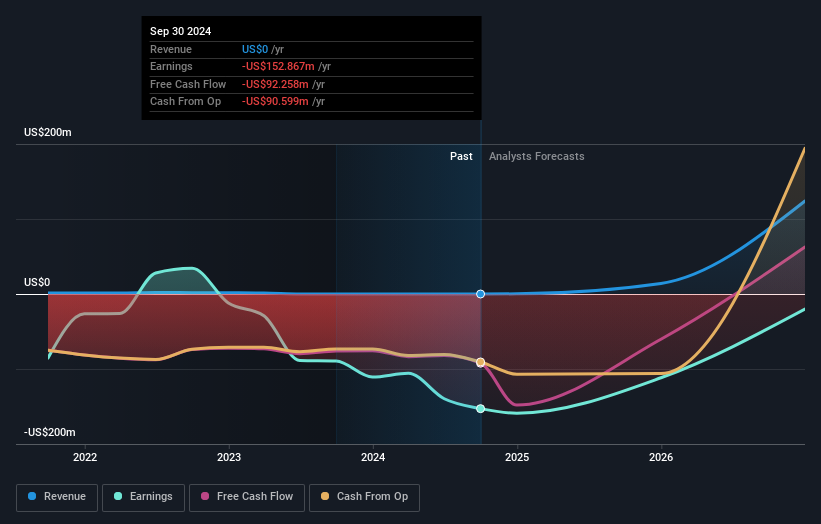- United States
- /
- Biotech
- /
- NasdaqGS:HUMA
Both individual investors who control a good portion of Humacyte, Inc. (NASDAQ:HUMA) along with institutions must be dismayed after last week's 9.1% decrease

Key Insights
- The considerable ownership by individual investors in Humacyte indicates that they collectively have a greater say in management and business strategy
- 48% of the business is held by the top 25 shareholders
- Insiders have been buying lately
To get a sense of who is truly in control of Humacyte, Inc. (NASDAQ:HUMA), it is important to understand the ownership structure of the business. We can see that individual investors own the lion's share in the company with 46% ownership. That is, the group stands to benefit the most if the stock rises (or lose the most if there is a downturn).
While institutions, who own 28% shares weren’t spared from last week’s US$53m market cap drop, individual investors as a group suffered the maximum losses
Let's delve deeper into each type of owner of Humacyte, beginning with the chart below.
Check out our latest analysis for Humacyte

What Does The Institutional Ownership Tell Us About Humacyte?
Many institutions measure their performance against an index that approximates the local market. So they usually pay more attention to companies that are included in major indices.
We can see that Humacyte does have institutional investors; and they hold a good portion of the company's stock. This implies the analysts working for those institutions have looked at the stock and they like it. But just like anyone else, they could be wrong. If multiple institutions change their view on a stock at the same time, you could see the share price drop fast. It's therefore worth looking at Humacyte's earnings history below. Of course, the future is what really matters.

Hedge funds don't have many shares in Humacyte. Fresenius Medical Care AG is currently the largest shareholder, with 14% of shares outstanding. In comparison, the second and third largest shareholders hold about 6.9% and 5.9% of the stock.
Our studies suggest that the top 25 shareholders collectively control less than half of the company's shares, meaning that the company's shares are widely disseminated and there is no dominant shareholder.
While it makes sense to study institutional ownership data for a company, it also makes sense to study analyst sentiments to know which way the wind is blowing. There are a reasonable number of analysts covering the stock, so it might be useful to find out their aggregate view on the future.
Insider Ownership Of Humacyte
While the precise definition of an insider can be subjective, almost everyone considers board members to be insiders. Company management run the business, but the CEO will answer to the board, even if he or she is a member of it.
Insider ownership is positive when it signals leadership are thinking like the true owners of the company. However, high insider ownership can also give immense power to a small group within the company. This can be negative in some circumstances.
Our most recent data indicates that insiders own some shares in Humacyte, Inc.. In their own names, insiders own US$51m worth of stock in the US$549m company. It is good to see some investment by insiders, but it might be worth checking if those insiders have been buying.
General Public Ownership
The general public, who are usually individual investors, hold a 46% stake in Humacyte. While this size of ownership may not be enough to sway a policy decision in their favour, they can still make a collective impact on company policies.
Public Company Ownership
We can see that public companies hold 14% of the Humacyte shares on issue. It's hard to say for sure but this suggests they have entwined business interests. This might be a strategic stake, so it's worth watching this space for changes in ownership.
Next Steps:
While it is well worth considering the different groups that own a company, there are other factors that are even more important. Case in point: We've spotted 4 warning signs for Humacyte you should be aware of, and 2 of them are significant.
If you are like me, you may want to think about whether this company will grow or shrink. Luckily, you can check this free report showing analyst forecasts for its future.
NB: Figures in this article are calculated using data from the last twelve months, which refer to the 12-month period ending on the last date of the month the financial statement is dated. This may not be consistent with full year annual report figures.
Valuation is complex, but we're here to simplify it.
Discover if Humacyte might be undervalued or overvalued with our detailed analysis, featuring fair value estimates, potential risks, dividends, insider trades, and its financial condition.
Access Free AnalysisHave feedback on this article? Concerned about the content? Get in touch with us directly. Alternatively, email editorial-team (at) simplywallst.com.
This article by Simply Wall St is general in nature. We provide commentary based on historical data and analyst forecasts only using an unbiased methodology and our articles are not intended to be financial advice. It does not constitute a recommendation to buy or sell any stock, and does not take account of your objectives, or your financial situation. We aim to bring you long-term focused analysis driven by fundamental data. Note that our analysis may not factor in the latest price-sensitive company announcements or qualitative material. Simply Wall St has no position in any stocks mentioned.
About NasdaqGS:HUMA
Humacyte
Engages in the development and manufacture of off-the-shelf, implantable, and bioengineered human tissues for the treatment of diseases and conditions across a range of anatomic locations in multiple therapeutic areas.
High growth potential slight.


